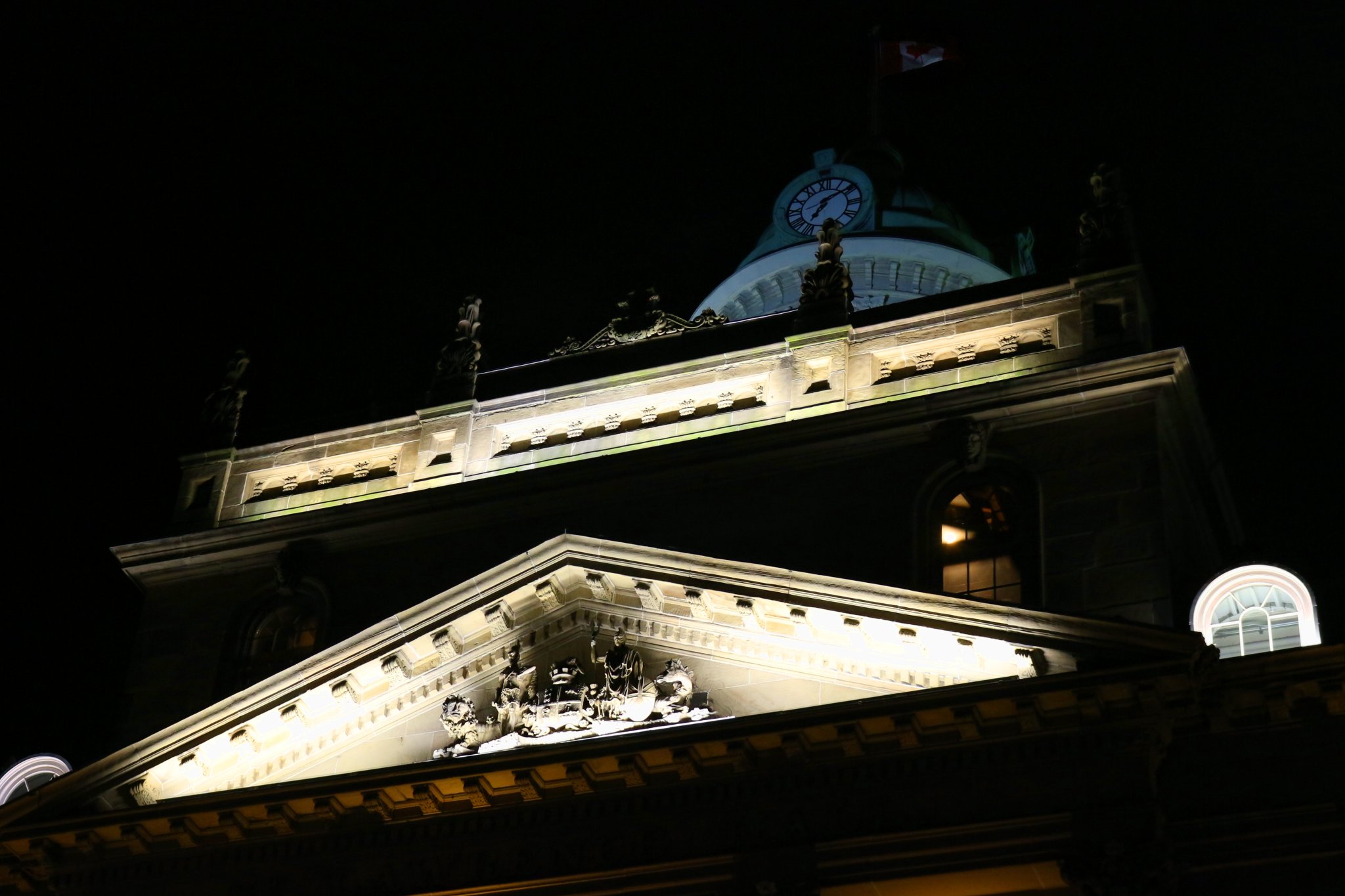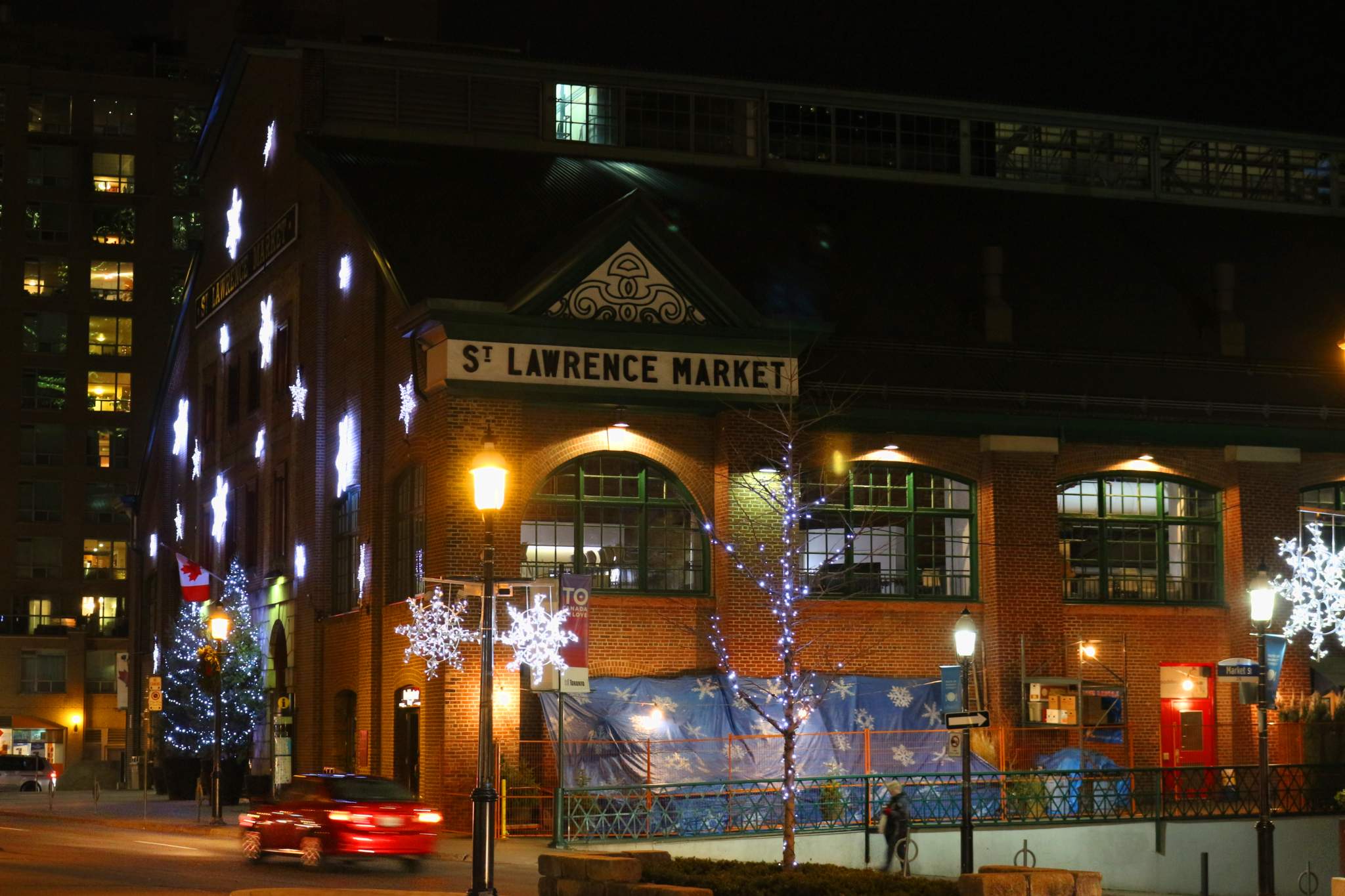Every town should have one (top photo)
I’m pretty sure that every great town has a few great markets in it – and somehow we are attracted to them deeply, without often stopping to think about their extraordinary cultural inertia. I will admit first-fondness for the far rougher, punkier and more youthfully dynamic Kensington Market (which was always within bicycle distance, when I was a kid), but St Lawrence Market is an irreplaceable treasure for our city, nevertheless.
The site was first set aside for a market in 1803 (first public well dug, too), and a wooden market building was constructed in 1820 – replaced with a grand brick colonnade in 1831. Between 1834 and 1844, the population of Toronto tripled (this factoid is news to me, too, but explains much – and this just before the massive influx of refugees from the Irish famine also – two huge and surprisingly rapid transformations for our city). The windfall in tax revenues paid for a brand new city hall – on the site of this very market, which was utterly destroyed, along with the original brick market, by the great fire of Toronto in 1849 – (also called the Cathedral fire since it destroyed the original St James, and to distinguish it from the 1904 fire – which is also frequently called the ‘great fire of Toronto’).
This 1845 building was originally the replacement city hall, but it has been modified and modified again over the years, massively and repeatedly – only traces of the original remain – and yet it’s many metamorphic transformations have been handled well. For it’s present purpose, it could not be more magnificent.
Within, you will find all of the foods of the world – and I don’t just mean odd canned goods, I’m talking sublime rare cheeses and fantastic fresh fish and grains that we may well never learn how to pronounce properly, and all of their special sub-varieties too. Roasted Eggplant and veal sandwiches to die-for (if you’re going to deal with the devil, bargain hard). Perfectly burnt custard tarts. Perfectly braided strudel. Pasta you’ve never seen, fruits you’ve never tasted – essentially – all the very best stuff from everywhere.
And no I’m not just boasting as a proud local – National Geographic named it the best food market in the entire world in 2012 – friendly hilarious people too – plus there’s a gallery level above where you can sit and eat and watch the brilliant chaos in all it’s wild interactings – a writer’s dream! (Eater’s and chef’s, too).

St Lawrence Hall
On what was (then) essentially the same giant lot (now a full block north) – we also find the far more overtly beautiful St Lawrence Hall, built in 1850, and thankfully still quite itself, after all this time. I remember an early walking date with Catherine where we snuck upstairs to the grand hall (what velvet rope?), and tiptoed across the creaky stage (when you’re a punk, security tends to tell you to leave as soon as they spot you) and then just couldn’t resist having a go anyhow, when we discovered the original warp-bodied ancient grand piano. Excruciatingly out of tune – but such extraordinary timbre – an almost heterodyning bliss/nausea cognition problem that still resonates for me today!
This was once the centre of Toronto politics, (John A spoke regularly on the second floor, in the same hall where we tickled the ancient ivories) commerce, (the first floor was occupied by many upscale shops) and even the Irish Catholic Benevolent Union, who held their meetings in St Patrick hall on the third floor. A building with a whole lot of history.
As the city grew, bigger specialized concert venues and more desirable commercial real estate gradually wore down the hall’s centrality and glory – though the National Ballet of Canada did reside here for many years, which always adds a real note of high class, even when the repair budget is way behind for decades.
The whole place was finally renovated as part of the centenary celebrations in 1967 – and we’ve been there for many odd events including stamp fairs, space keener meets and antique publication jumbles (hay-fever of the centuries – but on the other hand – stereoscopic daguerrotypes!). Wasn’t all so easy, mind you – in 1971 a city committee proposed knocking down the lovely old market. Organized people power is what got it not just saved but also renovated, instead – grazie, my friends – nice work!

Not quite us at all (and yet so like us as to make us laugh)
One final note – I wondered why the name St Lawrence? Discovered it was not a particular fancy titled Empire type person who was being honoured – but rather the Patron Saint of Canada itself (as well as the name of that political ward within the city). Who knew?
So, as research will do to us – I found myself wondering into: who was this Saint Lawrence anyhow? I’m no authority on such matters, so I’ll stay out of the grander debates and just give you the basic story I think worth having, whether or not it’s precisely true (such stories don’t last so long for no reason).
In 257, when he was only 32, St Lawrence was made one of seven deacons of the Christian church in Rome and given a very serious job, managing church finances and the distribution of alms to the poor. Even back then he was considered very young for such a heavy role, but he performed marvellously. Integrity personified.
In early August of 258 Emperor Valerian declared that all bishops priests and deacons should be put to death – within days, the pope and all the other deacons were apprehended and martyred. Lawrence was the last fugitive at that level to be caught, and so was technically the senior figure of the church in Rome (age 33, now).
The emperor demanded that he turn over the wealth of the church at once. Lawrence asked for three days in order to gather it all together in one place, for the handover. During those three days he gave away every last single bit of it to the poor. When the emperor demanded the money be produced, Lawrence instead brought along a gathering of indigent and hungry waifs and proudly declared the poor to be the truest treasures of the church.
His Martyrdom – August 10, 253, is not in doubt. But I especially like the extra bit which is the source of considerable argument. The tradition holds that the infuriated emperor actually ordered him to be roasted on a gridiron (grille). And that, in a display of superhuman fortitude and temperament, he was heard to cheerfully declare after spending quite some time in this torture, “I’m well-done on this side, turn me over,” Making him to this day the patron saint of chefs and comedians both.
And Canada.
All of which new found information and inspiration I will definitely (and happily) toast, next time I pop a cork (or crack open a can, for that matter). Nice choice. (and choice night)
¯\_(ツ)_/¯

Guinness time (some of these nearby pubs, are almost as old)









